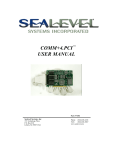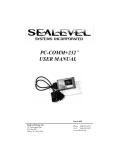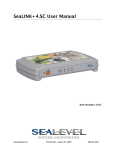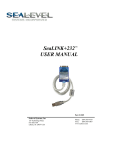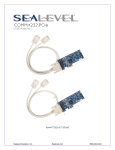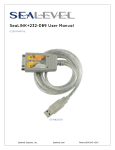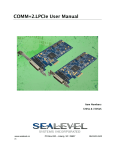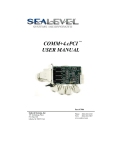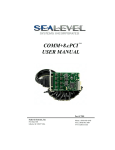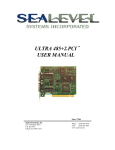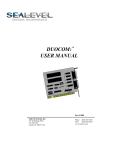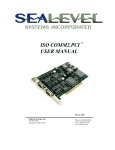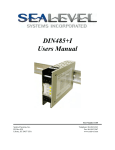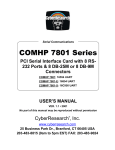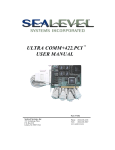Download COMM+850.PCI USER MANUAL
Transcript
COMM+850.PCI USER MANUAL TM Part # 7104 Sealevel Systems, Inc 155 Technology Place P.O. Box 830 Liberty, SC 29657 USA Phone: (864) 843-4343 FAX: (864) 843-3067 www.sealevel.com Contents INTRODUCTION ........................................................................ 1 OVERVIEW ...........................................................................................1 WHAT’S INCLUDED..............................................................................1 CARD SETUP............................................................................. 1 ADDRESS AND IRQ SELECTION.............................................................1 CLOCK MODES.....................................................................................1 BAUD RATES AND DIVISORS FOR THE ‘D1’ MODE...............................2 INSTALLATION.......................................................................... 3 OPERATING SYSTEM INSTALLATION ....................................................3 For Windows Users .......................................................................3 Other Operating Systems ..............................................................3 SYSTEM INSTALLATION .......................................................................3 TECHNICAL DESCRIPTION ....................................................... 4 CONNECTOR P IN ASSIGNMENTS ...........................................................4 RS-232 (DB-25 Male DTE)..........................................................4 SPECIFICATIONS ....................................................................... 5 ENVIRONMENTAL SPECIFICATIONS.......................................................5 MANUFACTURING................................................................................5 P OWER CONSUMPTION ........................................................................5 MEAN TIME BETWEEN FAILURES (MTBF) ..........................................5 P HYSICAL DIMENSIONS........................................................................5 APPENDIX A - TROUBLESHOOTING ......................................... 6 APPENDIX B - HOW TO GET ASSISTANCE ............................... 7 APPENDIX C - ELECTRICAL INTERFACE .................................. 8 RS-232...............................................................................................8 APPENDIX D - ASYNCHRONOUS COMMUNICATIONS .............. 9 APPENDIX E - SILK-SCREEN .................................................. 10 APPENDIX F - COMPLIANCE NOTICES ................................... 11 FEDERAL COMMUNICATIONS COMMISSION STATEMENT ...................11 CANADIAN RADIO INTERFERENCE REGULATIONS ..............................11 EMC DIRECTIVE STATEMENT ...........................................................12 WARRANTY ............................................................................ 13 © 2001e Sealevel Systems, Incorporated. All rights reserved. Introduction and Card Setup Introduction Overview The Sealevel COMM+850.PCI is a single channel PCI Bus serial I/O adapter. It provides one RS-232 serial port supporting data rates up to 460.8K bps. What’s Included The COMM+850.PCI is shipped with the following items. If any of these items is missing or damaged, contact the supplier. • • COMM+850.PCI Serial I/O Adapter Sealevel Software Card Setup Address and IRQ selection The COMM+850.PCI is automatically assigned resources by your motherboard BIOS. Only the I/O address may be modified by the user. Adding or removing other hardware may change the assignment of I/O addresses and IRQs. Clock Modes The COMM+850.PCI employs a unique clocking option that allows the end user to select from divide by 4 and divide by 1 clocking modes. These modes are selected at Header J1. To select the Baud rates commonly associated with COM: ports (i.e. 2400, 4800, 9600, 19.2, … 115.2K bps ) place the jumper in the divide by 4 mode (silk-screen D4) position. To select the maximum data rates up to 460.8K bps place the jumper in the divide by 1 (silk-screen D1) position. Please refer to the following page for these additional data rates. Sealevel Systems COMM+850.PCI Page 1 Introduction and Card Setup Baud Rates and Divisors for the ‘D1’ mode The following table shows some common data rates and the rates you should choose if using the adapter in the ‘D1’ mode. For this Data Rate 1200 bps 2400 bps 4800 bps 9600 bps 19.2K bps 57.6 K bps 115.2 K bps 230.4K bps 460.8K bps Choose this Data Rate 300 bps 600 bps 1200 bps 2400 bps 4800 bps 14.4K bps 28.8K bps 57.6 K bps 115.2 K bps If your communications package allows the use of Baud rate divisors, choose the appropriate divisor from the following table: For this Data Rate 1200 bps 2400 bps 4800 bps 9600 bps 19.2K bps 38.4K bps 57.6K bps 115.2K bps 230.4K bps 460.8K bps Sealevel Systems COMM+850.PCI Choose this Divisor 384 192 96 48 24 12 8 4 2 1 Page 2 Installation Installation Operating System Installation For Windows Users Start by choosing Install Software at the beginning of the CD. Choose Asynchronous COM: Port Software, SeaCOM. Other Operating Systems Refer to the appropriate section of the Serial Utilities Software. System Installation The COMM+850.PCI can be installed in any of the PCI expansion slots and contains several jumper straps for each port that must be set for proper operation. 1. 2. 3. 4. Turn off PC power. Disconnect the power cord. Remove the PC case cover. Locate an available PCI slot and remove the blank metal slot cover. Gently insert the COMM+850.PCI into the slot. Make sure that the adapter is seated properly. 5. Replace the screw. 6. Replace the cover. 7. Connect the power cord. Installation is complete. Sealevel Systems COMM+850.PCI Page 3 Technical Description Technical Description The Sealevel Systems COMM+850.PCI provides a versatile interface for any RS-232 device including modems, printers and plotters. The COMM+850.PCI utilizes the 16850 UART. This chip features programmable baud rates, data format, interrupt control and industry leading 128-byte FIFOs. Connector Pin Assignments RS-232 (DB-25 Male DTE) TD RTS DTR GND RD DCD DSR CTS RI Name Transmit Data Request To Send Data Term Ready Ground Receive Data Data Carrier Detect Data Set Ready Clear To Send Ring Indicator Sealevel Systems COMM+850.PCI Pin # 2 4 20 7 3 8 6 5 22 Mode Output Output Output Input Input Input Input Input Page 4 Specifications Specifications Environmental Specifications Specification Temperature Range Operating 0º to 50º C (32º to 122º F) 10 to 90% R.H. Non-Condensing Humidity Range Storage -20º to 70º C (-4º to 158º F) 10 to 90% R.H. Non-Condensing Manufacturing All Sealevel Systems Printed Circuit boards are built to U. L. 94V0 rating and are 100% electrically tested. These printed circuit boards are solder mask over bare copper or solder mask over tin nickel. Power Consumption Supply line Rating +12VDC 50 mA -12VDC 50 mA +5 VDC 300 mA Mean Time Between Failures (MTBF) Greater than 150,000 hours. (Calculated) Physical Dimensions Board length Board Height including Goldfingers Board Height excluding Goldfingers Sealevel Systems COMM+850.PCI 4.9 inches 2.6 inches 2.275 inches (12.45 cm) (6.60 cm) (5.78 cm) Page 5 Appendix A - Troubleshooting Appendix A - Troubleshooting Sealevel Software is supplied with the Sealevel Systems adapter and may be used in the troubleshooting procedures. Using this software and following these simple steps can eliminate most common problems without the need to call Technical Support. 1. Identify all I/O adapters currently installed in your system. This includes your on-board serial ports, controller cards, sound cards etc. The I/O addresses used by these adapters, as well as the IRQ (if any) should be identified. 2. Configure your Sealevel Systems adapter so that there is no conflict with currently installed adapters. No two adapters can occupy the same I/O address. 3. Make sure the Sealevel Systems adapter is using a unique IRQ. While the Sealevel Systems adapter does allow the sharing of IRQs, many other adapters (i.e. SCSI adapters & on-board serial ports) do not. The IRQ is typically selected via an on-board header block. Refer to the section on Card Setup for help in choosing an I/O address and IRQ. 4. Make sure the Sealevel Systems adapter is securely installed in a motherboard slot. 5. When running DOS or Windows 3.x refer to the supplied Sealevel Software and this User Manual to verify that the Sealevel Systems adapter is configured correctly. This software contains a diagnostic program ‘SSD’ that will verify if an adapter is configured properly. This diagnostic program is written with the user in mind and is easy to use. 6. For Windows95/98/ME/NT/2000, the diagnostic tool ‘WinSSD’ is installed in the SeaCOM folder on the Start Menu during the setup process. First find the ports using the Device Manager, then use ‘WinSSD’ to verify that the ports are functional. 7. Always use the Sealevel Systems diagnostic software when troubleshooting a problem. This will eliminate any software issues from the equation. Sealevel Systems COMM+850.PCI Page 6 Appendix B - How To Get Assistance Appendix B - How To Get Assistance Please refer to Appendix A – Troubleshooting prior to calling Technical Support. 1. Read this manual thoroughly before attempting to install the adapter in your system. 2. When calling for technical assistance, please have your user manual and current adapter settings. If possible, please have the adapter installed in a computer ready to run diagnostics. 3. Sealevel Systems maintains a Home page on the Internet. Our home page address is www.sealevel.com. The latest software updates, and newest manuals are available via our FTP site that can be accessed from our home page. 4. Technical support is available Monday thru Friday from 8:00 a.m. to 5:00 p.m. eastern time. Technical support can be reached at (864) 843-4343. RETURN AUTHORIZATION MUST BE OBTAINED FROM SEALEVEL SYSTEMS BEFORE RETURNED MERCHANDISE WILL BE ACCEPTED. AUTHORIZATION CAN BE OBTAINED BY CALLING SEALEVEL SYSTEMS AND REQUESTING A RETURN MERCHANDISE AUTHORIZATION (RMA) NUMBER. Sealevel Systems COMM+850.PCI Page 7 Appendix C – Electrical Interface Appendix C - Electrical Interface RS-232 Quite possibly the most widely used communication standard is RS-232. This implementation has been defined and revised several times and is often referred to as RS-232 or EIA/TIA-232. The IBM PC computer defined the RS-232 port on a 9 pin D sub connector and subsequently the EIA/TIA approved this implementation as the EIA/TIA-574 standard. This standard is defined as the 9-Position Non-Synchronous Interface between Data Terminal Equipment and Data Circuit-Terminating Equipment Employing Serial Binary Data Interchange. Both implementations are in wide spread use and will be referred to as RS-232 in this document. RS-232 is capable of operating at data rates up to 20 Kbps at distances less than 50 ft. The absolute maximum data rate may vary due to line conditions and cable lengths. RS-232 is a single ended or unbalanced interface, meaning that a single electrical signal is compared to a common signal (ground) to determine binary logic states. The RS-232 and the EIA/TIA-574 specification define two types of interface circuits, Data Terminal Equipment (DTE) and Data Circuit-Terminating Equipment (DCE). The COMM+850.PCI is a DTE device. Sealevel Systems COMM+850.PCI Page 8 Appendix D - Asynchronous Communications Appendix D - Asynchronous Communications Serial data communications implies that individual bits of a character are transmitted consecutively to a receiver that assembles the bits back into a character. Data rate, error checking, handshaking, and character framing (start/stop bits) are pre-defined and must correspond at both the transmitting and receiving ends. Asynchronous communications is the standard means of serial data communication for PC compatibles and PS/2 computers. The original PC was equipped with a communication or COM: port that was designed around an 8250 Universal Asynchronous Receiver Transmitter (UART). This device allows asynchronous serial data to be transferred through a simple and straightforward programming interface. A start bit, followed by a pre-defined number of data bits (5, 6, 7, or 8) defines character boundaries for asynchronous communications. The end of the character is defined by the transmission of a pre-defined number of stop bits (usually 1, 1.5 or 2). An extra bit used for error detection is often appended before the stop bits. Idle state of line Odd, Even 5 to 8 Data Bits or Unused Remain Idle or next start bit 1 P STOP BIT 0 1 1.5 2 Figure 1 - Asynchronous Communications Bit Diagram This special bit is called the parity bit. Parity is a simple method of determining if a data bit has been lost or corrupted during transmission. There are several methods for implementing a parity check to guard against data corruption. Common methods are called (E)ven Parity or (O)dd Parity. Sometimes parity is not used to detect errors on the data stream. This is refereed to as (N)o parity. Because each bit in asynchronous communications is sent consecutively, it is easy to generalize asynchronous communications by stating that each character is wrapped (framed) by pre-defined bits to mark the beginning and end of the serial transmission of the character. The data rate and communication parameters for asynchronous communications have to be the same at both the transmitting and receiving ends. The communication parameters are baud rate, parity, number of data bits per character, and stop bits (i.e. 9600,N,8,1). Sealevel Systems COMM+850.PCI Page 9 Appendix E - Silk-Screen Appendix E - Silk-Screen 2.60" 4.90" Sealevel Systems COMM+850.PCI Page 10 Appendix F - Compliance Notices Appendix F - Compliance Notices Federal Communications Commission Statement This equipment has been tested and found to comply with the limits for Class B digital device, pursuant to Part 15 of the FCC Rules. These limits are designed to provide reasonable protection against harmful interference when the equipment is operated in a residential installation. This equipment generates, uses, and can radiate radio frequency energy and, if not installed and used in accordance with the instruction manual, may cause harmful interference to radio communications. However, there is no guarantee that interference will not occur in a particular installation. If this equipment does cause harmful interference to radio or television reception, which can be determined by turning the equipment off and on, the user is encouraged to try to correct the interference by one or more of the following measures: • Reorient or relocate the receiving antenna • Increase the separation between the equipment and receiver • Connect the equipment into an outlet on a circuit different from that to which the receiver is connected • Consult the dealer or an experienced radio/TV technician for help Caution Sealevel Systems, Inc. is not responsible for any radio or television interference caused by unauthorized modifications of this equipment or the substitution of attachment of connecting cables and equipment other than those specified by Sealevel Systems. Such unauthorized modifications, substitutions, or attachments may void the user’s authority to operate the equipment. The correction of interference caused by such unauthorized modifications, substitutions, or attachments will be the responsibility of the user. Always use cabling provided with this product if possible. If no cable is provided or if an alternate cable is required, use high quality shielded cabling to maintain compliance with FCC directives. Canadian Radio Interference Regulations This Class B digital apparatus meets all requirements of the Canadian Interference-Causing Equipment Regulations. Cet Appareil numérique de la classe B respecte toutes les exigences de Règlement sur le matériel du Canada Sealevel Systems COMM+850.PCI Page 11 Appendix F - Compliance Notices EMC Directive Statement Products bearing the CE Label fulfill the requirements of the EMC directive (89/336/EEC) and of the low-voltage directive (73/23/EEC) issued by the European Commission. To obey these directives, the following European standards must be met: EN55022 Class B - ‘Limits and methods of measurement of radio interference characteristics of information technology equipment’. EN55024 -'Information technology equipment characteristics Limits and methods of measurement'. Immunity EN60950 (IEC950) - ‘Safety of information technology equipment, including electrical business equipment’. Always use cabling provided with this product if possible. If no cable is provided or if an alternate cable is required, use high quality shielded cabling to maintain compliance with EMC directives. Sealevel Systems COMM+850.PCI Page 12 Warranty Warranty Sealevel Systems, Inc. provides a lifetime warranty for this product. Should this product fail to be in good working order at any time during this period, Sealevel Systems will, at it's option, replace or repair it at no additional charge except as set forth in the following terms. This warranty does not apply to products damaged by misuse, modifications, accident or disaster. Sealevel Systems assumes no liability for any damages, lost profits, lost savings or any other incidental or consequential damage resulting from the use, misuse of, or inability to use this product. Sealevel Systems will not be liable for any claim made by any other related party. RETURN AUTHORIZATION MUST BE OBTAINED FROM SEALEVEL SYSTEMS BEFORE RETURNED MERCHANDISE WILL BE ACCEPTED. AUTHORIZATION CAN BE OBTAINED BY CALLING SEALEVEL SYSTEMS AND REQUESTING A RETURN MERCHANDISE AUTHORIZATION (RMA) NUMBER. Sealevel Systems, Incorporated 155 Technology Place P.O. Box 830 Liberty, SC 29657 USA (864) 843-4343 FAX: (864) 843-3067 www.sealevel.com email: [email protected] Technical Support is available from 8 a.m. to 5 p.m. Eastern time. Monday - Friday Trademarks Sealevel Systems, Incorporated acknowledges that all trademarks referenced in this manual are the service mark, trademark, or registered trademark of the respective company. COMM+850.PCI is a trademark of Sealevel Systems, Incorporated. Sealevel Systems COMM+850.PCI Page 13
















